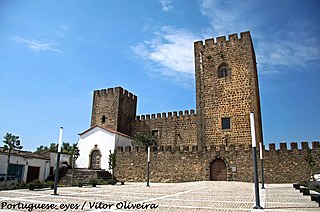
Lisbon is the capital and largest city of Portugal, with an estimated population of 567,131 as of 2023 within its administrative limits and 2,961,177 within the metropolis. Lisbon is mainland Europe's westernmost capital city and the only one along the Atlantic coast, the others being on islands. The city lies in the western portion of the Iberian Peninsula, on the northern shore of the River Tagus. The western portion of its metro area, the Portuguese Riviera, hosts the westernmost point of Continental Europe, culminating at Cabo da Roca.

The District of Leiria is a district located between the Oeste e Vale do Tejo and Centro regions of Portugal, and divided between the traditional provinces of Beira Litoral and Estremadura. It borders on the north with district of Coimbra, on the east with district of Castelo Branco and with district of Santarém, on the south with district of Lisbon and on the west with the Atlantic Ocean. The district capital is the city of Leiria.

Lisboa e Vale do Tejo was one of the five regions of Portugal. Today two of the subregions are in the new Lisboa Region, two in the Centro Region and one in the Alentejo Region.

The Ribatejo is the most central of the traditional provinces of Portugal, with no coastline or border with Spain. The region is crossed by the Tagus river. The region contains some of the nation's richest agricultural land, and it produces most of the animals used in the Portuguese style of bullfighting.

Lisbon Region is one of the seven NUTS II designated regions of Portugal, which coincides with the NUTS III subregion Lisbon Metropolitan Area. The region covers an area of 3001.95 km2 and includes a population of 2,815,851 inhabitants according to the 2011 census, a density of 1039 inhabitants/km2.

The Comunidade Intermunicipal da Lezíria do Tejo is an administrative division in Portugal. It was established as an Associação de Municípios in 1987, converted into a Comunidade Urbana in 2003, and converted into a Comunidade Intermunicipal in November 2008. It is also a NUTS3 subregion of the Oeste e Vale do Tejo. The seat of the intermunicipal community is the city of Santarém. Lezíria do Tejo comprises municipalities of the former districts of Santarém and Lisbon. The population in 2011 was 247,453, in an area of 4,275 square kilometres (1,651 sq mi). In the past, the territory of this administrative division was roughly entirely set in the historic province of Ribatejo and had nothing to do with the historic province of Alentejo. Lezíria is the Portuguese word for floodplain or freshwater marsh. Tejo is the name of the main river in the region. The Lezíria is a well-renowned center of intensive farming, horse breeding and animal husbandry.

The Parque das Nações, colloquially known as Expo, is a freguesia and typical quarter of Lisbon, the capital city of Portugal. Located in eastern Lisbon, Parque das Nações is to the east of Olivais, northeast of Marvila, and directly south of Lisbon's border with Loures. The population in 2021 was 22,382.

Olivais is a freguesia and typical quarter of Lisbon, the capital city of Portugal. Located in eastern Lisbon, Olivais is west of Parque das Nações, north of Marvila and Alvalade, and east of Lumiar and Santa Clara. The population in 2021 was 32,179.

Super Bock Super Rock is a music festival in Portugal that takes place annually since 1995. It is organized by the Portuguese live entertainment company Música no Coração and is named after its main sponsor, the beer brand Super Bock.

The Tagus International Natural Park is a protected area in Portugal and Spain. It is an important area for the conservation of several species of birds that nest on the rugged banks of rivers and surrounding areas. It is also one of the lowest human density areas in the Iberian Peninsula.

The Amieira do Tejo Castle is a Portuguese castle in the civil parish of Amieira do Tejo, municipality of Nisa, in the antique district of Portalegre, approximately 200 kilometres from the city of Lisbon.

The Metro Transportes Sul do Tejo is a light rail system that provides mass-transit services for the Almada and Seixal municipalities in Portugal.
Lisbon Bridge may refer to:

Areeiro is a station on the Green Line of the Lisbon Metro serving the Areeiro neighbourhood. The station is located in the Praça Francisco Sá Carneiro, just south of the Roma-Areeiro railway station.
Cabo Ruivo Seaplane Base was an international airport for seaplanes located in the city of Lisbon, the capital of Portugal. It takes its name from the Lisbon neighbourhood of Cabo Ruivo. The airport was, especially throughout the Second World War, a major gateway and escape route for intercontinental air travel.

Oriente is a station on the Red Line of the Lisbon Metro. The station is located in Lisbon, between the Cabo Ruivo and Moscavide stations. The station is a part of the Gare do Oriente, one of the main transport hubs of the city, serving the North, Sintra, and Azambuja Lines and also several bus lines.

The Museum of Art, Architecture and Technology (MAAT) is a museum in Lisbon, Portugal.

World Youth Day 2023 was the 2023 installment of World Youth Day, a recurring Catholic festival. The 2023 event was held in Lisbon, Portugal, which was announced at World Youth Day 2019 in Panama City, Panama.
Super Bock Super Rock is a music festival in Portugal, organized yearly since 1995. It has been held in various places throughout the years.
















